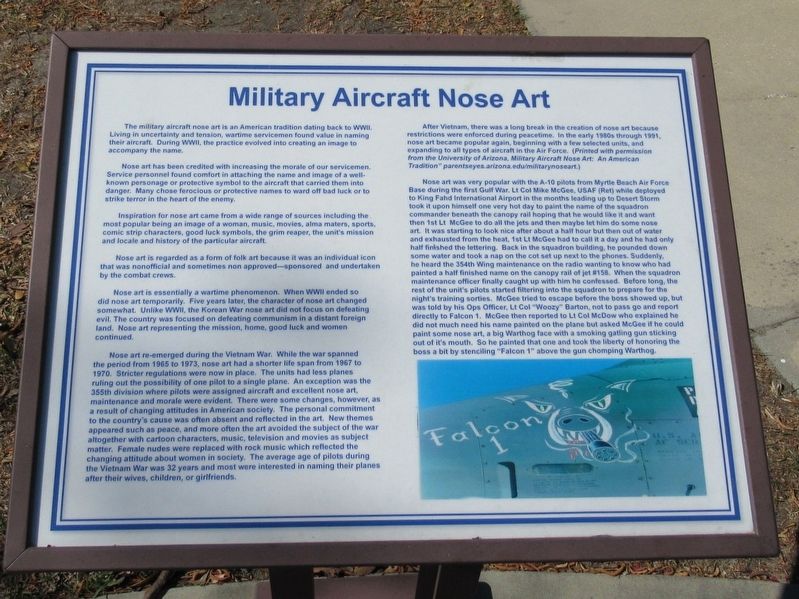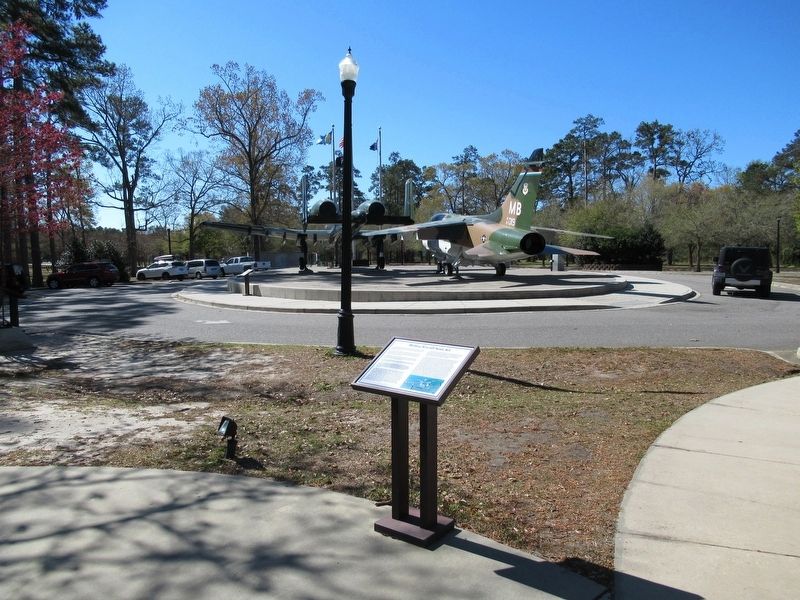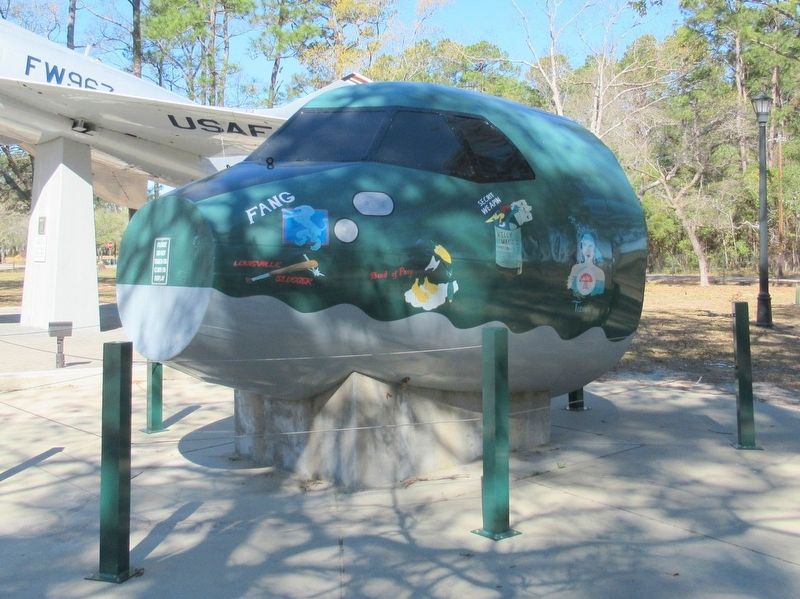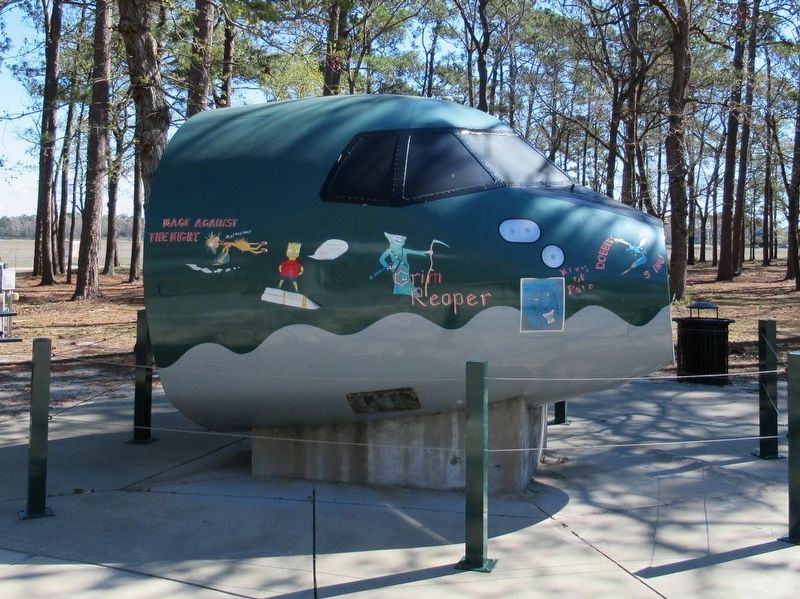Myrtle Beach in Horry County, South Carolina — The American South (South Atlantic)
Military Aircraft Nose Art
The military aircraft nose art is an American tradition dating back to WWII. Living in uncertainty and tension, wartime servicemen found value in naming their aircraft. During WWII, the practice evolved into creating an image to accompany the name.
Nose art has been credited with increasing the morale of our servicemen. Service personnel found comfort in attaching the name and image of a well- known personage or protective symbol to the aircraft that carried them into danger. Many chose ferocious or protective names to ward off bad luck or to strike terror in the heart of the enemy.
Inspiration for nose art came from a wide range of sources including the most popular being an image of a woman, music, movies, alma maters, sports, comic strip characters, good luck symbols, the grim reaper, the unit's mission and locale and history of the particular aircraft.
Nose art is regarded as a form of folk art because it was an individual icon that was nonofficial and sometimes non approved — sponsored and undertaken by the combat crews.
Nose art is essentially a wartime phenomenon. When WWII ended so did nose art temporarily. Five years later, the character of nose art changed somewhat. Unlike WWII, the Korean War nose a did not focus on defeating evil. The country was focused on defeating communism in a distant foreign land. Nose art representing the mission, home, good luck and women continued.
Nose art re-emerged during the Vietnam War. While the war spanned the period from 1965 to 1973, nose art had a shorter life span from 1967 to 1970. Stricter regulations were now in place. The units had less planes ruling out the possibility of one pilot to a single plane. An exception was the 355th division where pilots were assigned aircraft and excellent nose art, maintenance and morale were evident. There were some changes, however, as a result of changing attitudes in American society. The personal commitment to the country cause was often absent and reflected in the art. New themes appeared such as peace, and more often the art avoided the subject of the war altogether with cartoon characters, music, television and movies as subject matter. Female nudes were replaced with rock music which reflected the changing attitude about women in society. The average age of pilots during the Vietnam War was 32 years and most were interested in naming their planes after their wives, children, or girlfriends.
After Vietnam, there was a long break in the creation of nose art because restrictions were enforced during peacetime. In the early 1980s through 1991 nose art became popular again, beginning with a few selected units, and expanding to all types of aircraft i the Air Force. (Printed with permission from the University of Arizona, Military Aircraft Nose Art: An American Tradition" parentseyes.arizona.edu/militarynoseant.)
Nose art was very popular with the A-10 pilots from Myrtle Beach Air Force Base during the first Gulf War. Lt Col Mike McGee, USAF (Ret) while deployed to King Fahd International Airport in the months leading up to Desert Storm took it upon himself one very hot day to paint the name of the squadron commander beneath the canopy rail hoping that he would like it and want then 1st Lt McGee to do all the jets and then may be let him do some nose art. It was starting to look nice after about a half hour but then out and exhausted from the heat, 1st Lt McGee had to call it a day and he had only half finished the lettering. Back in the squadron building, he pounded down some water and took a nap on the cot set up next to the phones. Suddenly he heard the 354th Wing maintenance on the radio wanting to know who had painted a half finished name on the canopy rail of jet #158. When the squadron maintenance officer finally caught up with him he confessed. Before long, the rest of the unit's pilots started filtering into the squadron to prepare for the night's training sorties. McGee tried to escape before the boss showed up, but was told by his ops officer, Lt Col "Woozy" Barton, not to pass go and report directly to Falcon 1. McGee then reported to Lt Col McDow who explained he did not much need his name painted on the plane but asked McGee if he could paint some nose art, a big Warthog face with a smoking gatling gun sticking out of it's mouth. So he painted that one and took the liberty of honoring the boss a bit by stenciling "Falcon 1" above the gun chomping Warthog.
Topics. This memorial is listed in this topic list: Military.
Location. 33° 39.696′ N, 78° 55.718′ W. Marker is in Myrtle Beach, South Carolina, in Horry County. Memorial is at the intersection of Farrow Parkway and South Kings Highway, on the right when traveling north on Farrow Parkway. Located in the Warbird Park next to Myrtle Beach International Airport. Touch for map. Marker is in this post office area: Myrtle Beach SC 29577, United States of America. Touch for directions.
Other nearby markers. At least 8 other markers are within walking distance of this marker. Warrior (a few steps from this marker); The F - 100D at MBAFB, 1956 - 1970 (a few steps from this marker); 354th Fighter Group History (a few steps from this marker); LTV A-7 Corsair II (a few steps from this marker); P-51 Mustang (within shouting distance of this marker); Fairchild A-10 Thunderbolt II (within shouting distance of this marker); Myrtle Beach Air Force Base (within shouting distance of this marker); 354th Wing Inactivation (within shouting distance of this marker). Touch for a list and map of all markers in Myrtle Beach.
Credits. This page was last revised on March 23, 2017. It was originally submitted on March 23, 2017, by Michael Herrick of Southbury, Connecticut. This page has been viewed 297 times since then and 13 times this year. Photos: 1, 2, 3, 4. submitted on March 23, 2017, by Michael Herrick of Southbury, Connecticut.



